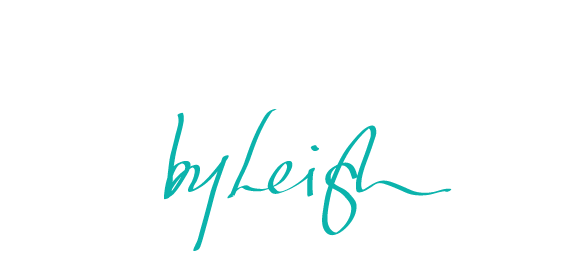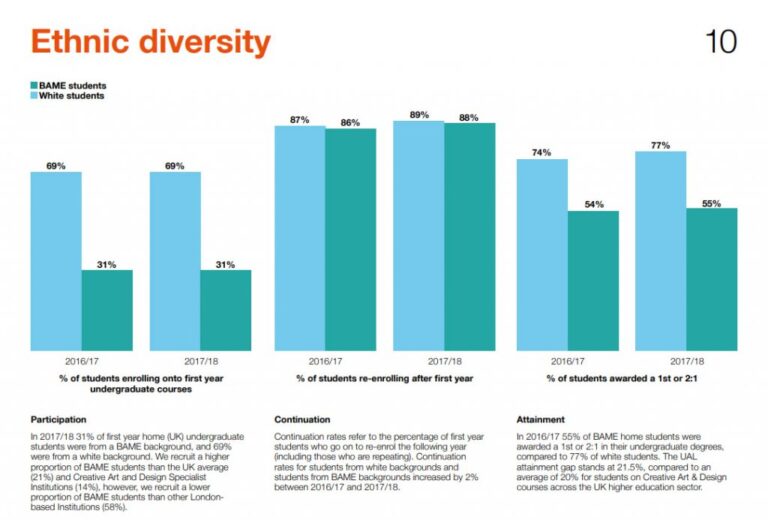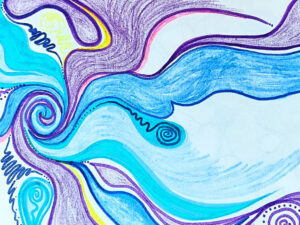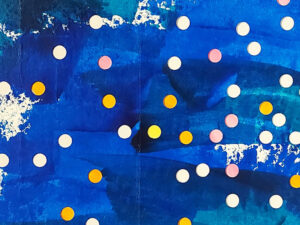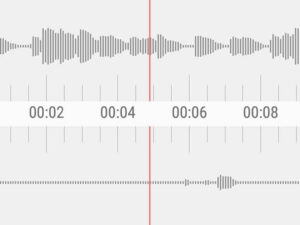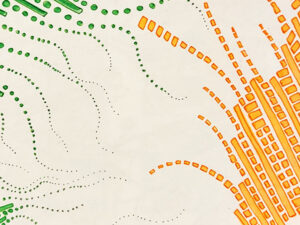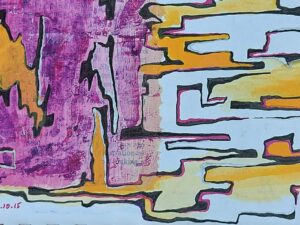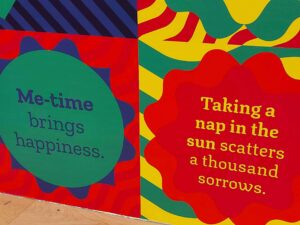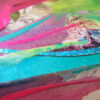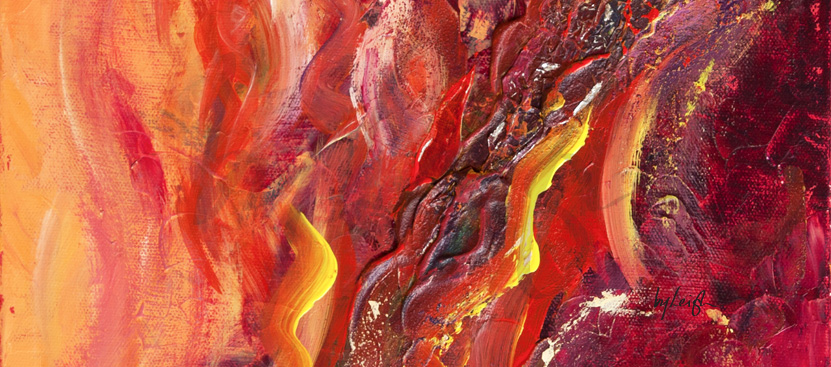
Featured Image: Partial of The Fire in My Belly by Stacey Leigh Ross
9 Apr 2019
Please note that an edited version of this blog post has been published in Shades of Noir’s journal titled Inclusive Practice: Alchemy – Transformation in Social Justice Teaching.
The third and final Inclusive Teaching & Learning Practice lecture and they didn’t pull any punches.
Heavy…
This was a heavy session.
In the morning we looked at a lot of ‘touchy’ subjects. Subjects that need to be addressed but often aren’t because they are so uncomfortable. One of the Tutors discussed a quote about Whiteness being “unmarked and unnamed”[i]. That really hit home. I had never thought about it like that. It’s the default measure by which everything is rated, it feels like pretty much everything is identified in comparison to white.
In my last blog, I mentioned that what I want from white people is their discomfort, not apologies or shame or anything like that. It felt really good to hear this same concept of discomfort coming up in class and realising that even before this session I was already on the right track with my thinking. As a newcomer to the ‘woke’ party, I often feel wary of saying the wrong thing and saying too much (not that you’d guess that from these blogs. Ha!) So today, I don’t know if I got my discomfort wish granted but I do know I learned something important about myself – I am uncomfortable listening to truthful information about race in the presence of white people. There, I said it.
In discussing the concept of Whiteness, we listened to an excerpt from Robin Diangelo’s audiobook White Fragility[ii]. She is frank and brutal with her dissemination of the truth and I listened to it like a split personality. One half of me was like “Yea sister, tell it like it is!” The other half of me was cringing and bracing for impact – how much am I going to have to pacify while I try to justify and explain? How much energy will I need to use up trying not to cause offence while still getting the white people around me to open their minds to this information? That is an exhausting task and I’m operating on about five hours of sleep. I don’t think I’m up for this today.
An Ally & An Oppressor…
Then I met an ally. I love allies. It’s like finding a port in the storm. They let you know that no, you didn’t imagine that, and remind you that yes you have a right to be angry, and plot right alongside you to topple the instruments of oppression. And sitting right beside me was an ally. She was surprised by my discomfort (girl, me too!) and her response to the audio was so matter of fact – Yep! Total truth. Where can I get this book? She just wanted to know and understand more so she could figure out how to dismantle this shit too. I cannot tell you how much that means to me. Muah x
By contrast, in total opposition to all the Critical Race Theory, White Supremacy, Whiteness and White Fragility information we learned not four hrs earlier, one of my peers repeatedly stated that no examples of good non-white artists could be found in a particular art discipline. Even in the face of repeated polite but firm opposition, this person held the position that it was incredibly hard to find good non-white artists in this field. When presented with two examples of not only non-white but female professional artists in that discipline, the response was something along the lines of “I can’t just include artists because they aren’t white, their work needs to be good”. Deep breath.
Several people challenged this with gently phrased comments like..
(a) You will have to look harder for them because they will have been historically excluded from prominent recognised spaces,
(b) I just did a Google search. Here’s one who is a black female professor at a US uni,
(c) Surely it’s worth it to really dig for the information. This is the work that we’re about.
(c) Here’s the name of one I know [insert name] check her out,
(d) What is your definition of good? What informs that definition? Perhaps the culture of the artist changes the definition of good?
That last comment was mine, and I received a very condescending response delivered with an equally condescending smile,
“well some things just aren’t good practice. I can’t include something with an inky thumb print, it’s just not good enough”
The Lesson that Churns…
I stopped talking at that point. My mum says that if you have nothing good to say, say nothing and I was losing my ability to be professional so I shut up. The insinuation that BAME artists are incapable of good practice and could not produce ‘good’ work is downright insulting and I have to wonder, what prompted this person to sign up for an inclusivity course if they have no intention of truly being inclusive.
Talk about White Supremacy in action – there you stand supporting institutional, systematic racist power games, acting like the gate keeper who says “I really want to let you in” with your mouth, but your actions scream “You don’t belong here. You are inferior and I will NEVER let you in”. Did somebody force you to take this class?
I could honesty feel my blood pounding, my heart racing, my stomach churning. It was like swallowing acid listening to the “I just can’t find any good work from BAME artists” mantra repeated over and over and over. It’s people who think like this person that make people who look like me invisible.
Later that evening, I was relating the incident to my husband and thinking out loud that I was a bit disappointed with myself. I should have been more than capable of dealing with this. How will I facilitate difficult discussions if I shutdown and shut up to avoid losing my isht? And as soon as I asked the question, I knew the answer.
This one cut deep because I was not expecting it. For some reason I felt that the Inclusive Teaching & Learning Unit was meant to be a safe space because we were all there to learn how to create more inclusivity in our students’ experience. How naïve of me! So for me this felt like it came out of left field. Why are we on this course, if not to be more inclusive? I forgot Rule #1 that my mum taught me – Nobody owes you anything. Just because you treat someone a certain way does not under any circumstances mean that they will offer you the same courtesy (or discourtesy). So maybe there are other reasons that people are on this course. Whatever it is, I’ve learned my lesson. Expect anything from anyone any time and the Inclusive Unit is no different.
Another lesson for me is that as much as it burns a hole in my gut, anyone convinced against their will is of the same opinion still. Say your piece respectfully, politely, debate calmly where possible and if you realise they are closed to discussion, stop wasting your breath, agree to disagree and move on.
Ok, so moving on…
Stats…
While all the stats made me think, I found myself really pondering the Participation, Continuation and Attainment bar charts[iii].
BAME Participation was comparatively low, as was their attainment stats, but their Continuation stats were almost on par with White students. It doesn’t make sense to me. If you enrol a small number of BAME students but they stick with the programme showing as much determination to complete their course as White students then how is the Attainment showing such disparity? The ones who make it to UAL are sticking it out but not achieving as much? I guess most of them must not be ‘good’ artists as my learned peer suggested. Stacey… let it go.
When we switched group partners, it was interesting that when next I ended up being the only BAME student in the group, we didn’t actually discuss what the stats said to us but rather the legitimacy of the stats. This was because one member expressed complete distrust of statistics. Without knowing how the stats were gathered there was room for doubt. So a definite lesson here is if you want to use statistics and have the reader stay on topic and focused, then provide access to the background info e.g. show the nature of questions, forms, explain what was compulsory / optional, and so on. In this way, when you make your point, no one can claim they distrust it. They’ve got all the reference info to wade through if they want. Then if they still refuse to believe what is obviously in front of their eyes then “Houston, we have a problem”, and it aint the stats.
Critical Race Theory (CRT)…
Apart from the storytelling element (Hello! Did someone call my name?) the thing that really excited me with CRT[iv] was its inclusion of activism as a key element. Not just academia talking about its own brilliance in a vacuum, but moving that theory into practice and making a real life everyday difference with the knowledge gained. Finally an academic approach I can absolutely get behind. This is the crux of my art practice, my teaching practice, me as a person – I create to inspire change that will leave this world a better place than I found it. I will definitely be going on to read more about CRT as I’m thoroughly curious, particularly about the transition from theory to practice and how this has been applied in the past. I feel like CRT might have many ideas and concepts that could really develop my approach to teaching and creating. As a final note on this topic, I was also very curious about all the faces of diversity and inclusion ground breakers. Who are they and what were their contributions? Man, I have so much reading to do!
Feedback Literacy…
Let’s start with how much I like this term. It makes sense because not everyone knows how to give constructive feedback. Makes me remember our session with Vicky Hill for the Teaching & Learning Unit where she advised us not to give subjective feedback like “I like” or “I think it’s good” because that is useful only to the person giving the feedback, no one else. I know that at present, I rely on instinct when giving feedback but it would be better to have a stronger framework to bring order to the way I use those instincts. Some ideas we learnt were:
- Plant Seeds – I love this idea of planting seeds when giving feedback so that students can grow them.
- Balancing Act – I am familiar with the idea of striking a balance between praise and critique. Although I did this in the past, the Teaching & Learning microteaching session actually gave me a great framework to do this called “Two Stars & A Wish” – the stars being the praise, and the wish being the criticism.
- Advance Research – When I’m in a more permanent post it will be easier to doing research on students’ topics in advance to get familiar with things I don’t know. At the moment, I make up for this by doing the research afterwards and emailing them with additional tips after I have a 1-2-1 with them.
- Micro-implications and micro-affirmations – need look this one up more. Not very clear on it.
In the afternoon we got into presentations and that deserves a blog by itself. Click here for the presentation blog.
So to recap today’s big lessons for me –
- I get uncomfortable unpacking race topics in front of white people. I can see the work coming a mile away and it’s a heavy load.
Take away – learn to navigate and swim competently in the discomfort. - Nobody owes you anything. Expect anything from anyone any time, even in ‘safe’ spaces.
Take away 1 – Feel the hurt or preferably let it slide off your back. Either way, do not pick up the muck left behind by someone else’s issues, that’s for them to deal with, not you.
Take away 2 – If you speak your truth in a manner that does not disdain others, you will never have cause to regret your words. - Have a bit more faith in yourself girl. I am powerful and somehow manage to be on the right track even when I don’t know exactly where I’m going.
- Note your obsession with art for social change and building compassion. Funny how you end up right back at the same end point no matter where you start.
- I love being validated but hey, who doesn’t.
References –
[i] Richards & Finnigan (2019) ‘Lecture 3’ [PowerPoint presentation]. Inclusive Teaching & Learning Practice Unit. [Internal Document] Unpublished.
[ii] Diangelo, R (2019) White Fragility: Available at: https://www.audible.co.uk/pd/White-Fragility-Audiobook/0141990848?source_code=M2M30DFT1BkSH121515013C&ipRedirectOverride=true (Accessed: 9 April 2019, 6 minutes of the audiobook was played to the class)
[iii] University of the Arts London (2018) UAL: Student Equality, Diversity and Inclusion Report 2018. Available at: https://www.arts.ac.uk/__data/assets/pdf_file/0021/89211/UAL-Equality-Diversity-Inclusion-Report-2018.pdf (Accessed: 9 April 2019)
[iv] There is no one text for this. Just look up Derrick Bell and Critical Race Theory to find multiple books, articles, videos, etc that will fly at you. Have fun!
